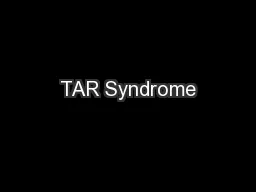PPT-TAR Syndrome
Author : tatyana-admore | Published Date : 2016-07-25
Pediatric Diagnosis Paper Josh Hensley Ryan Hua Gary Pearson and Johnny Rider TAR Syndrome Etiology and Prevalence TAR syndrome is a genetic disorder which causes
Presentation Embed Code
Download Presentation
Download Presentation The PPT/PDF document "TAR Syndrome" is the property of its rightful owner. Permission is granted to download and print the materials on this website for personal, non-commercial use only, and to display it on your personal computer provided you do not modify the materials and that you retain all copyright notices contained in the materials. By downloading content from our website, you accept the terms of this agreement.
TAR Syndrome: Transcript
Download Rules Of Document
"TAR Syndrome"The content belongs to its owner. You may download and print it for personal use, without modification, and keep all copyright notices. By downloading, you agree to these terms.
Related Documents














